Весь Ваш инструмент вибрирует, когда Вы играете на нём. Не только верхняя дека, но и весь гриф вместе с головкой колеблются, раскачиваемые энергией струн. Любой плохо пригнанный или незатянутый элемент гитары может жужжать или дребезжать. Иногда это происходит только когда Вы берёте определённую ноту, а иногда постоянно. Не всегда такие проблемные части гитары заметны на глаз, и тогда приходится долго искать причину дребезга.
Очень часто для определения проблемного места можно простучать Ваш инструмент в различных местах костяшками пальцев. Если Вы стучите по корпусу, а шум идёт со стороны грифа, значит, вероятнее всего, что-то плохо прикручено в грифе или на головке грифа. Если же шум появляется только при постукивании по нижней деке, то, видимо, внутри отклеилась пружина, и так далее. Если пытаетесь отследить таинственное жужжание, не забудьте обратиться к нашей Диагностике жужжания.
Давайте обратимся к некоторым частям акустической гитары, которые чаще всего становятся причиной жужжания. В принципе, у большинства ладовых инструментов есть аналогичные части, так что многие из приведённых ниже советов подойдут владельцам мандолин, банджо и так далее.
Логичнее всего начинать диагностику с головки грифа, так как там наибольшее количество прикрученных деталей. Практически все части колков потенциально могут раскрычиваться и дребезжать. Под гайками на верхней части головки грифа находятся тонкие шайбы, чтобы защитить полированную поверхность. Гайки плотно закручиваются при сборке гитары, однако они могут ослабнуть, если дерево немного сожмётся. Через несколько месяцев после покупки хорошо бы слегка подкрутить эти гайки. Дребезжащие шайбы — основная причина дребезга в районе головки грифа.
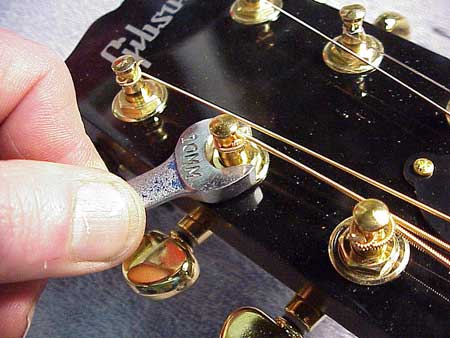
Эти впрессованные втулки дребезжат:
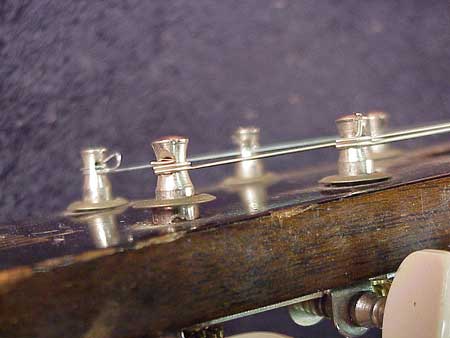
Tuner buttons become loose for a variety of reasons. Sometimes the little retaining screws just back themselves out a little, and the button starts to rattle sympathetically at certain frequencies:
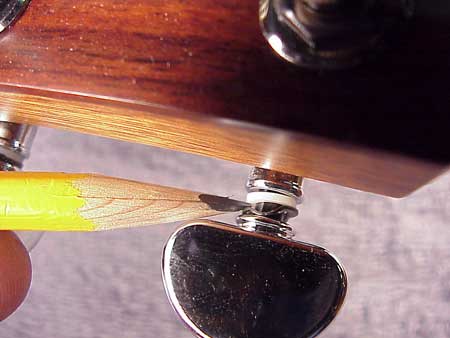
Simply tightening the screw will fix this one nicely.
Here, I'm dropping a tiny bit of very thin acrylic glue onto the button shaft to secure the little decorative collar. It is almost imperceptibly loose, but it makes a nasty noise when the instrument is played:
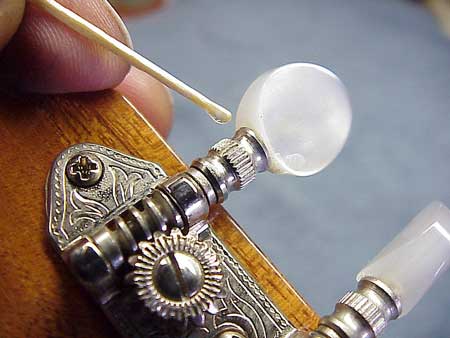
Truss rod covers don't have to be damaged as this one in order to be loose enough to rattle:
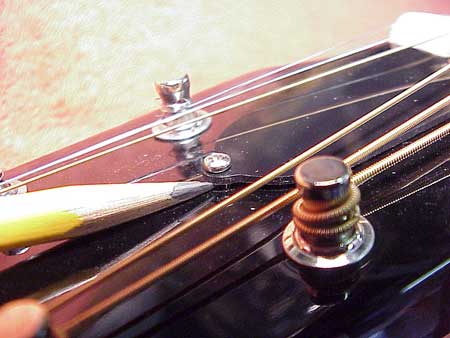
Rattling, loose truss rod covers are not common, but they certainly are annoying.
Underneath the cover, though, the truss rod nut may be loose, and it or the washer under it may make a lot of noise:

Even if no tension is needed on the truss rod it's generally a good idea to tighten the truss rod nut just enough to keep it from coming unscrewed and allowing the washer to become loose.
Still concentrating on the peghead, we can hear a special kind of string buzz if a string passes too close to a tuning post:

Here the string is held at just the right distance to cause it to buzz with a peculiar "fuzzy" note. You can avoid this rattle by noticing how the string touches its neighbor when you restring the guitar. If the design of the peghead won't allow enough clearance, then make sure the string rubs tightly against the post by adding a few extra turns around the offending post. The string should either miss the post altogether, or it should be held against the post tightly enough so it doesn't rattle. It may sound tricky, but it is very easy to keep this problem under control as you restring the guitar.
The free end of the string should be cut short so it doesn't dangle around and rattle or buzz:
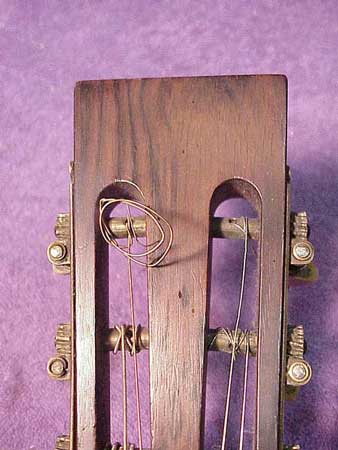
A clumped up mass of extra string at the peghead may have a casual or folksy look, but it can be a source of nasty noises.
The strings themselves can have loose windings, particularly when they become very old and worn:
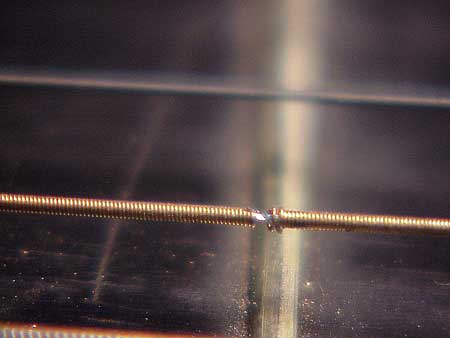
A string with severed windings like these will make just about the worst, deadest, buzzing noise you can get from an acoustic guitar!
Inside its neck, the steel string guitar usually has an adjustable truss rod:

Even if this rod is a bit loose, it generally doesn't rattle when the guitar is played. But sometimes, a truss rod may be either loose or tight, and may just graze the inside wall of the slot into which it is installed. Play just the right note, and the truss rod sings out loudly from inside the neck as it vibrates sympathetically. If you change the adjustment of the rod just a hair, you might keep it from rattling. The conventional repair for a rattling truss rod is to inject a bit of glue through a tiny hole drilled through the fingerboard down into the cavity that houses the truss rod. In skilled hands, this is a very safe procedure
More